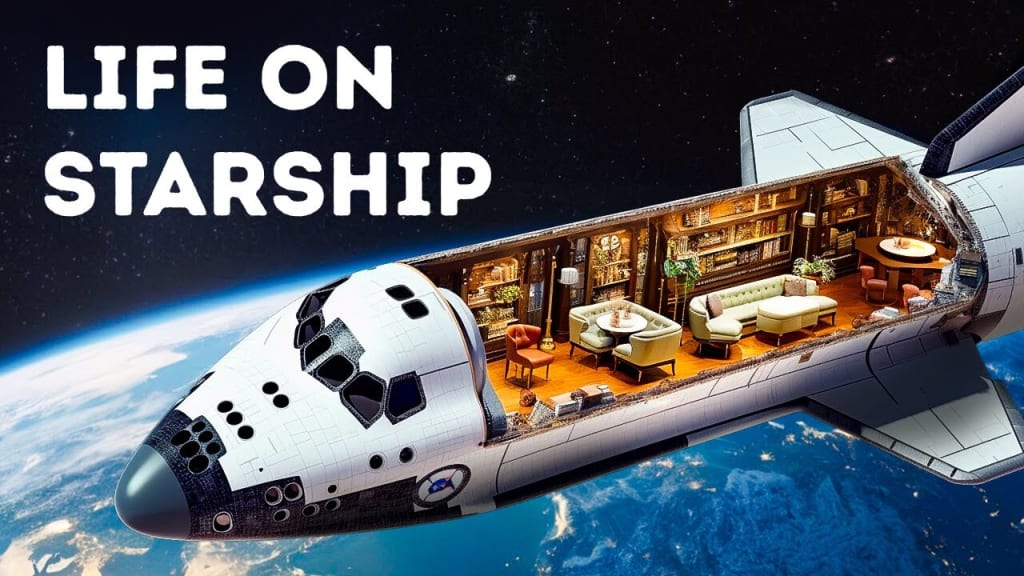What Our Life Will Be Like on a Real Spaceship
What Our Life Will Be Like on a Real Spaceship

Ladies and gentlemen, this is your captain speaking. We'll be ready to take off in three, two, one. Living on a spaceship may seem like a topic from a sci-fi movie, but it's gradually evolving into a plan for the distant future. Let's imagine this cosmic journey without further ado, starting with the unique challenges and wonders of life in the vastness of space.
On Earth, the interplay of sunlight, atmosphere, and shadows creates a dynamic environment. However, inside a spaceship, there's no sky to scatter sunlight, resulting in a lack of ambient light. Picture a spacecraft within a solar system, with one side basking in the brilliance of a nearby star, while the other remains in shadow—an experience akin to the phases of a Crescent Moon. To counter the absence of natural light, advanced technology might use LED light panels to simulate sunlight, ensuring inhabitants hardly notice the difference.
The prospect of space habitation leads us to the selection of crew members. A study suggests that a crew of 160 people could sustain a viable population for 200 years. The key lies in choosing crew members from a diverse gene pool to maintain genetic diversity. Perhaps, in the future, entire countries might find residence in a spaceship, turning neighboring countries on Earth into neighbors in the vastness of space.
Considering potential destinations, Proxima Centauri B, an exoplanet in a neighboring star system, emerges as a promising candidate. Though located almost 25 trillion miles away, scientists believe it might harbor liquid water on its surface. The journey to Proxima Centauri B, even with the fastest spaceships, would take thousands of years, emphasizing the need for breakthroughs in space travel technology.
Addressing the lifespan of humans becomes a crucial factor in this cosmic venture. Generation ships, where each generation takes over the journey, present a solution. Alternatively, advancements in longevity or cryogenic freezing could alter the trajectory of interstellar exploration.
Living on a generation spacecraft entails a unique set of challenges and adjustments. Dating may lose its romantic allure, with a geneticist regulating reproduction, and freedom of choice diminishing. Occupations would be assigned based on merits, aptitudes, passions, and available jobs, ensuring a well-functioning community. This structured system may bring to mind scenarios from movies like Snowpiercer, but with a humane and efficient approach.
Crucial issues such as water supply and waste management would need innovative solutions. Systems to recycle waste into pure water already exist, reflecting a commitment to sustainable practices. Furthermore, maintaining a balance of bacteria and microbes in the spaceship becomes essential for a robust immune system.
Considering the vastness of space and potential isolation, shielding against radiation gains significance. A formidable shield, possibly a force field, would protect inhabitants from the harsh conditions of deep space. The ship's interior may feature dedicated sections for farming and livestock, ensuring a sustainable supply of food. The inclusion of parks and mini ecosystems would contribute to the mental well-being of spaceship residents, providing a semblance of natural environments.
Education and recreation would be integral components of life on a generation ship. Playgrounds, schools, and cabins for education would become essential, with a curriculum tailored to surviving on a foreign planet. High-tech robots and artificial intelligence would likely play a significant role in maintaining ship functions and exploring potential new habitats.
While the concept of generation ships may seem derived from Hollywood blockbusters, initiatives like the 100-Year Starship project suggest a serious exploration of interstellar possibilities. Theoretical designs, like the Icarus probe, showcase potential ways to achieve interstellar travel, though challenges like creating artificial gravity remain.
The journey doesn't end with reaching a new habitable planet. A strategic plan for exploration, settlement, and coexistence with potential extraterrestrial life forms becomes paramount. From self-defense gadgets to tools for building homes, the crew would need to be prepared for diverse scenarios.
In this vision of the future, space travel might become a routine part of life. Occupations could include live space travel guides, and planetary visas might be required for entry into habitable planets. Whether settling on Europa, Proxima Centauri B, or beyond, the possibilities for a thriving interstellar society are both fascinating and challenging.
So, how do you envision a vessel capable of carrying humanity from one solar system to another? Share your thoughts on the design of interstellar ships. If this cosmic exploration has piqued your curiosity, give the video a like, share it with your friends, and stay tuned for more insights into the wonders of the bright side of the universe.
About the Creator
Enjoyed the story? Support the Creator.
Subscribe for free to receive all their stories in your feed. You could also pledge your support or give them a one-off tip, letting them know you appreciate their work.





Comments (1)
informative.